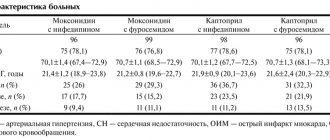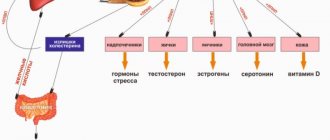Pharmacodynamics and pharmacokinetics
Lercanidipine is a typical calcium channel blocker that reduces the active transport of calcium ions through a semi-permeable membrane into cardiomyocytes of vascular smooth muscle cells. Under the influence of this substance, total peripheral vascular resistance and blood pressure . The hypotensive effect of taking the drug is quite long-lasting and lasts throughout the day. The medicine does not have a negative inotropic effect.
The substance is completely adsorbed from the gastrointestinal tract. The maximum concentration is observed one and a half to three hours after administration. The product is quickly distributed throughout all tissues and organs. The degree of binding to proteins in the blood is up to 98%. With hypoalbunemia , liver and kidney failure, the free fraction tends to increase. Repeated administration of the drug does not lead to its accumulation. Metabolized in the liver using the CYP3A4 , half of the drug taken is excreted through the kidneys in the urine. The half-life is from 7 to 10 hours.
Nephroprotective effect of lercanidipine
It is believed that dihydropyridine CCBs do not have nephroprotective properties, which is associated with their predominant effect on the afferent arteriole of the renal glomeruli. This creates conditions for increased intraglomerular pressure and progression of nephroangiosclerosis. The ability of lercanidipine to penetrate tissue creates the possibility of affecting both the afferent and efferent arterioles. Thus, the use of lercani dipina may help reduce intraglomerular pressure.
Nephroprotective effects have also been shown clinically. The most interesting are the results of the DIAL (Diabete, ipertensione, albuminuria, lercanidipina) study, which compared the effects of ramipril and lercanidipine on the condition of the kidneys of patients with hypertension and diabetes mellitus. The study included 277 patients with type 2 diabetes mellitus, hypertension of 1st and 2nd degrees of severity and microalbuminuria. Patients received therapy with lercanidipine at a dose of 10–20 mg/day or ramipril at a dose of 5–10 mg/day for 12 months. The dynamics of blood pressure and the level of albumin excretion in urine were monitored. By the end of treatment, the reduction in blood pressure was significant with both drugs and did not differ significantly between the groups. The decrease in albumin excretion rate was -17.4 ± 65 μg/min in the lercanidipine group (p < 0.05) and -19.7 ± 52.5 μg/min in the ramipril group (p < 0.05). The differences in the dynamics of albuminuria between the groups were not significant. Thus, the nephroprotective properties of lercanidipine were shown, in which it was not inferior to ACE inhibitors [20].
Lercanidipine may be a component of combination antihypertensive therapy for patients with chronic kidney disease. In a group of 69 patients with hypertension and proteinuria (albumin excretion more than 50 mg/day), the effectiveness of adding lercanidipine to antihypertensive therapy was studied. At inclusion, patients received antihypertensive therapy with ACE inhibitors or sartans, but did not achieve target blood pressure levels (BP remained above 130/80 mmHg). Lercanidipine was added to therapy at a dose of 20 mg/day. The degree of proteinuria was assessed after 1, 3 and 6 months of treatment, as well as creatinine clearance based on measurements of daily diuresis. During therapy, there was a significant decrease in systolic blood pressure. At the same time, in 42.5% of cases, the target blood pressure level was achieved, and of the remaining cases, in 58.8%, a decrease in blood pressure below 140/90 mm Hg was noted. Art. Blood creatinine levels and creatinine clearance did not change significantly during therapy. There was a significant decrease in the level of total cholesterol and triglycerides, as well as a significant decrease in proteinuria: by 23% after a month, by 37% after 3 and by 33% after 6 months of treatment. Thus, the addition of lercanidipine to therapy created additional hypotensive and nephroprotective effects [21].
In the ZAFRA study (Zanidip en Función Renal Alterada), the renoprotective properties of lercanidipine were studied in patients with hypertension and chronic renal failure (blood creatinine above 1.4 mg/dL and creatinine clearance below 70 ml/min). Of the 203 patients included in the study, 20% had diabetes. Lercanidipine was prescribed for 6 months to assess its effect on blood pressure and renal function. All patients at the beginning of the study received therapy with ACE inhibitors (63.4%) and angiotensin receptor blockers (36.6%), but patients with nephropathy did not achieve the target blood pressure level. After adding lercanidipine to therapy, 58.1% of patients achieved blood pressure of 130/85 mmHg. Art. Systolic blood pressure decreased from 162 ± 16.6 to 131.6 ± 11.6 mmHg. Art., diastolic – from 93.2 ± 8.3 to 78.2 ± 6.4 mm Hg. Art. At the same time, the creatinine level did not change significantly during therapy, and creatinine clearance increased from 41.8 ± 16.0 ml/min at the beginning of the study to 45.8 ± 18.0 ml/min at the end (p = 0.019). Patients showed a significant decrease in daily proteinuria - from 3.5 ± 3.2 to 2.8 ± 2.8 g/day - and a decrease in total cholesterol levels [22].
Lercanidipine can also be used in patients with severely reduced renal function. In patients with end-stage chronic renal failure, the effectiveness of lercanidipine and carvedilol was compared. Therapy lasted 8 weeks. The levels of blood pressure, glucose, creatinine, protein, cholesterol, triglycerides and potassium were monitored. The hypotensive effect of both drugs did not differ significantly. There were no significant differences in the dynamics of the main biochemical parameters, except for the level of potassium, which at the end of treatment was significantly higher in the carvedilol group [23].
Contraindications
The substance is contraindicated:
- for chronic heart failure in the stage of decompensation;
- for aortic stenosis and unstable angina ;
- if less than a month ago the patient suffered a myocardial infarction ;
- with severe liver failure;
- if the CK reaches less than 10 ml per minute;
- with galactosemia ;
- patients with lactose intolerance, with malabsorption syndrome of galactose , glucose ;
- pregnant women;
- children and teenagers;
- when breastfeeding;
- patients with allergies to the components of the drug and other dihydropyridine derivatives.
Side effects
Side effects from taking Lercanidipine are quite rare.
May appear:
- peripheral edema , flushing of the face;
- palpitations, chest pain;
- angina pectoris , asthenia , headache , tachycardia ;
- myocardial infarction , dizziness , nausea;
- indigestion, vomiting, stomach pain;
- diarrhea , gum hyperplasia;
- increased activity of liver enzymes (reversible), decreased blood pressure ;
- skin rashes, myalgia , polyuria , drowsiness .
Lercanidipine, instructions for use (Method and dosage)
The tablets are taken orally. In the morning, on an empty stomach. Not earlier than a quarter of an hour before meals. It is not recommended to chew the medicine. Take the tablets with plenty of water.
On average, the daily dosage is 10 mg, but it can be doubled. The daily dose can be increased in the second week of treatment.
For mild to moderate liver and kidney diseases, it is better not to increase the dosage, but to take the minimum active dose of 10 mg.
Hypotensive effect
The hypotensive effect of lercanidipine has been well studied. In order to lower blood pressure, the drug was tested in doses from 2.5 to 40 mg/day. When comparing the effectiveness of different doses of lercanidipine in a group of 243 patients with hypertension of the 1st and 2nd degrees of severity, it turned out that a dose of 2.5 mg/day did not cause significant changes in blood pressure. When taking lercanidipine at a dose of 5 mg/day, a significant decrease in only diastolic blood pressure was noted. Lercanidipine at a dose of 10 mg/day had a sufficient hypotensive effect, which was confirmed by data from 24-hour blood pressure monitoring [7]. Lercanidipine at a dose of 10 mg/day allows normalizing blood pressure in 54% of patients with hypertension of the 1st and 2nd degrees, 20 mg/day – in 63% of patients [8].
The drug creates a sufficient antihypertensive effect for patients with more severe hypertension. In an open, non-comparative study, the effectiveness of lercanidipine for patients with hypertension was analyzed depending on the degree of risk of cardiovascular complications. Lercanidipine was prescribed at a dose of 10 mg/day with further titration to 20 mg/day. The treatment lasted 6 months. A total of 3175 patients were treated (mean age: 63 ± 10 years). The risk of cardiovascular complications was low in 237 patients, moderate in 1396, high in 722, and very high in 820 patients. When patients with a higher risk were included, the initial blood pressure level was higher. The reduction in blood pressure in high-risk groups also turned out to be more significant. In the low-risk group, blood pressure decreased by -18.5/-13.8 mmHg. Art., medium risk – by -23/-15.2, high risk – by -24.4/- 16.1 and in the very high risk group – by -27.4/-17.4 mm Hg. Art. The drug was well tolerated. The most common side effects included edema (5.1%), headache (3.3%), dizziness (2.5%) and weakness (1%) [9].
In total, more than 20 thousand patients with hypertension of the 1st and 2nd severity were included in controlled studies of lercanidipine. The average reduction in blood pressure was 19–26 mm Hg for systolic. Art. and for diastolic – 13–15.
The effectiveness of lercanidipine is comparable to that of other CCBs. The LEAD study compared the effectiveness of three dihydropyridine CCB drugs - lercanidipine, felodipine and nifedipine GITS. The hypotensive effect, heart rate (HR) at rest and during exercise were studied. Data from mental tests before and after treatment were also assessed. The study involved 325 patients with a diastolic blood pressure level of 95–110 mmHg. Art. They were randomized to treatment with lercanidipine 10–20 mg/day, felodipine 10–20 or nifedipine 30–60 mg/day. After 4 and 8 weeks of treatment, all three groups showed a comparable decrease in blood pressure. The proportion of patients who responded well to therapy with these drugs was also comparable (about 75% in each group). There was no significant increase in heart rate both at rest and during exercise in any of the groups. The incidence of side effects such as weakness, swelling, and dizziness was lower in the lercanidipine group. Thus, edema developed in only 5.5% of patients taking lercanidipine, and in 14% of those taking other CCBs. The number of patients who discontinued treatment due to side effects was also the smallest in the lercanidipine group [10].
Lercanidipine is not inferior in its antihypertensive effectiveness to drugs from other main groups used in the treatment of hypertension. In patients with stage 1 and 2 hypertension, the effectiveness of lercanidipine and losartan was compared. Lercanidipine was prescribed at a dose of 10–20 mg/day, losartan at a dose of 50–100 mg/day. Normalization of diastolic blood pressure was recorded in 71% of patients in the lercanidipine group and in 65% in the losartan group. In the losartan group there was a significantly larger proportion of patients who required an increase in the dose of the drug. Drug tolerance did not differ significantly [11]. In elderly patients (age 60–85 years) with isolated systolic hypertension, a double-blind, placebo-controlled study with a crossover design examined the antihypertensive efficacy of enalapril at a dose of 20 mg/day, lercanidipine at a dose of 10 mg/day, and their combination. The duration of each treatment option was 4 weeks. The effectiveness of treatment was monitored according to medical monitoring and 24-hour blood pressure monitoring. Combination treatment turned out to be the most effective. It was also well tolerated [12].
In general, various comparative studies have shown that lercanidipine at a dose of 10 mg/day corresponds in its hypotensive effect to 50 mg captopril per day, 20 mg enalapril per day, 50 mg atenolol per day or 16 mg candesartan [13].
Interaction
Combination use of the drug with inhibitors of the CYP3A4 ( ketoconazole , erythromycin , itraconazole , ritonavir ) may weaken or increase the effect of the drug. Inducers of CYP3A4 (antidepressants, rifampicin ) reduce the antihypertensive effect of the drug. facilities.
When Lercanidipine is combined with grapefruit juice, its hypotensive effect is reduced.
Alcohol and ethanol containing drugs potentiate the effect of the drug.
This substance cannot be combined with cyclosporine , this leads to a significant increase in the plasma concentration of both substances.
The combined use of the drug with metoprolol and other beta-blockers leads to a decrease in the bioavailability of the drug.
The combination of Lercanidipine with midazolam at a dosage of 20 mg leads to an increase in the bioavailability of the drug in elderly patients.
When Lercanidipine is combined with digoxin, of digoxin increases . Careful monitoring of patients' condition is necessary.
Taking the drug in combination with 800 mg of cimetidine does not lead to changes in the pharmacokinetic parameters of the drug.
Simultaneous treatment with this substance and simvastatin is preferably carried out at different times of the day. Take lercanidipine in the morning and simvastatin before bed.
Efficacy of lercanidipine in elderly patients
An additional indication for the choice of CCBs as antihypertensive drugs is the elderly age of patients. Lercanidipine demonstrated good efficacy for patients with hypertension of different age groups. One study compared its effectiveness in different age groups. 375 patients under the age of 65 years and 315 patients over 65 years of age were included. Lercanidipine was prescribed at a dose of 10–20 mg/day. The effectiveness of lercanidipine, its dose at the end of treatment, and the need for combination therapy did not differ significantly in different age groups. The incidence of edema was small (3%) and did not differ between the two groups [14].
In a placebo-controlled, randomized trial, 144 elderly (60–85 years) patients were prescribed lercanidipine at a dose of 10 mg/day. Patients receiving lercanidipine had a significantly more pronounced decrease in systolic (15 and 7 mm Hg, respectively) and diastolic (10 and 6 mm Hg) blood pressure compared to the placebo group. The proportion of patients with normalization of blood pressure also turned out to be significantly higher: 59% in the lercanidipine group and 38% in the placebo group [15].
Lercanidipine is not inferior in effectiveness to other dihydropyridine CCBs in elderly patients. In elderly patients with isolated systolic hypertension, lercanidipine at a dose of 10–20 mg/day showed comparable antihypertensive efficacy to lacidipine at a dose of 2–4 mg/day [16]. In a similar comparison with nifedipine GITS at a dose of 30-60 mg, the antihypertensive effectiveness was similar, and the incidence of side effects in treatment with lercanidipine was significantly lower (19.4%) compared with treatment with nifedipine (28.4%). Edema developed significantly less frequently: 2.8% in the lercanidipine group and 10.1% in the nifedipine group [17].
Therapy with lercanidipine can lead to an improvement in mnestic-intellectual functions, which is especially important for patients in older age groups. This was shown in an open-label study where 467 patients over 40 years of age with grade 1 and 2 hypertension received lercanidipine for 6 months. Lercanidipine was prescribed at a dose of 10 mg/day. At the end of treatment, 98% of patients continued taking lercanidipine. Adequate blood pressure control was achieved in 68% of patients. Blood pressure decreased from 154.4/95.3 to 134.8/80.7 mm Hg. Art. According to testing data, by the end of treatment there was a significant improvement in mental functions, more significant for those patients for whom lercanidipine provided sufficient blood pressure control [18].
Nonsteroidal anti-inflammatory drugs (NSAIDs) cause an increase in blood pressure and reduce the effectiveness of selected antihypertensive therapy in patients with hypertension. Taking NSAIDs, often uncontrolled, is one of the reasons for hypertension resistance to therapy. This is especially significant for elderly patients, who have a high incidence of concomitant diseases of the musculoskeletal system. It is known that taking NSAIDs has the greatest effect on the effectiveness of angiotensin-converting enzyme inhibitors (ACEIs). For lercanidipine, a special study examined the effectiveness of the drug in patients with hypertension over 60 years of age taking NSAIDs. A total of 334 patients were included in the study, 280 completed the study. Blood pressure control was carried out according to 24-hour blood pressure monitoring data. First, patients received therapy with lercanidipine at a dose of 10 mg/day for 8 weeks. At the same time, a significant decrease in blood pressure was noted, which reached a level of 139/82 mm Hg. Art. Blood pressure control was achieved in 156 (55.7%) patients. Then a course of NSAID therapy (mainly diclofenac and naproxen) was started. Good blood pressure control was maintained in 128 patients. The blood pressure level of 28 patients slightly exceeded 140/90 mmHg. Art. There were no significant changes in blood pressure in the group as a whole. Thus, taking NSAIDs has little effect on the effectiveness of lercanidipine therapy [19].
Drugs containing (Lercanidipine analogues)
Level 4 ATC code matches:
Lacipil
Cordafen
Azomex
Nimodipine
Felodipin
Nifedipine
Farmadipin
Amlotop
Nimotop
Tenox
Nifecard HL
Cordipin
Felodip
Normodipine
Phenigidine
Norvask
Cordaflex
Lerkamen
Corinfar
Vero-Amlodipine
Analogues of lek. products: Zanidip-Recordati , Lercanidipine hydrochloride , Lernikor , Lerkamen 10 and 20 mg, Lercanorm , Coripren (multicomponent product), Enal L Combi (with enalapril ).



